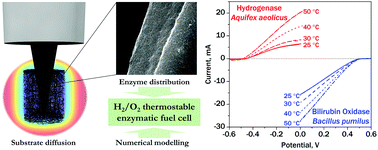当前位置:
X-MOL 学术
›
Energy Environ. Sci.
›
论文详情
Our official English website, www.x-mol.net, welcomes your feedback! (Note: you will need to create a separate account there.)
Impact of substrate diffusion and enzyme distribution in 3D-porous electrodes: a combined electrochemical and modelling study of a thermostable H2/O2 enzymatic fuel cell
Energy & Environmental Science ( IF 32.5 ) Pub Date : 2017-08-04 00:00:00 , DOI: 10.1039/c7ee01830d Ievgen Mazurenko 1, 2, 3, 4, 5 , Karen Monsalve 1, 2, 3, 4, 5 , Pascale Infossi 1, 2, 3, 4, 5 , Marie-Thérèse Giudici-Orticoni 1, 2, 3, 4, 5 , Frédéric Topin 5, 6, 7, 8, 9 , Nicolas Mano 2, 10, 11, 12, 13 , Elisabeth Lojou 1, 2, 3, 4, 5
Energy & Environmental Science ( IF 32.5 ) Pub Date : 2017-08-04 00:00:00 , DOI: 10.1039/c7ee01830d Ievgen Mazurenko 1, 2, 3, 4, 5 , Karen Monsalve 1, 2, 3, 4, 5 , Pascale Infossi 1, 2, 3, 4, 5 , Marie-Thérèse Giudici-Orticoni 1, 2, 3, 4, 5 , Frédéric Topin 5, 6, 7, 8, 9 , Nicolas Mano 2, 10, 11, 12, 13 , Elisabeth Lojou 1, 2, 3, 4, 5
Affiliation

|
Using redox enzymes as biocatalysts in fuel cells is an attractive strategy for sustainable energy production. Once hydrogenase for H2 oxidation and bilirubin oxidase (BOD) for O2 reduction have been wired on electrodes, the enzymatic fuel cell (EFC) thus built is expected to provide sufficient energy to power small electronic devices, while overcoming the issues associated with scarcity, price and inhibition of platinum based catalysts. Despite recent improvements, these biodevices suffer from moderate power output and low stability. In this work, we demonstrate how substrate diffusion and enzyme distribution in the bioelectrodes control EFC performance. A new EFC was built by immobilizing two thermostable enzymes in hierarchical carbon felt modified by carbon nanotubes. This device displayed very high power and stability, producing 15.8 mW h of energy after 17 h of continuous operation. Despite the large available electrode porosity, mass transfer was shown to limit the performance. To determine the optimal geometry of the EFC, a numerical model was established, based on a finite element method (FEM). This model allowed an optimal electrode thickness of less than 100 μm to be determined, with a porosity of 60%. Thanks to very efficient enzyme wiring and high enzyme loading, non-catalytic signals for both enzymes were detected and quantified, enabling the electroactive enzyme distribution in the porous electrode to be fully determined for the first time. High total turnover numbers, approaching 107 for BOD and 108 for hydrogenase, were found, as was an impressive massic activity of 1 A mg−1 with respect to the mass of the electroactive enzyme molecules. This strategy, relying on stable enzymes and mesoporous materials, and the model set up may constitute the basis for a larger panel of bioelectrodes and EFCs.
中文翻译:

底物扩散和酶在3D多孔电极中的分布的影响:热稳定的H 2 / O 2酶燃料电池的电化学和模型研究相结合
在燃料电池中使用氧化还原酶作为生物催化剂是可持续能源生产的一种有吸引力的策略。用于H 2氧化的一次氢化酶和用于O 2的胆红素氧化酶(BOD)由于已经在电极上进行了减少还原,因此预期构建的酶促燃料电池(EFC)将提供足够的能量来为小型电子设备供电,同时克服与稀缺性,价格和抑制铂基催化剂相关的问题。尽管最近进行了改进,但这些生物设备仍遭受中等功率输出和低稳定性的困扰。在这项工作中,我们演示了生物电极中底物的扩散和酶的分布如何控制EFC的性能。通过将两种热稳定酶固定在由碳纳米管改性的分级碳毡中,构建了新的EFC。该设备显示出非常高的功率和稳定性,在连续运行17小时后产生的能量为15.8 mW h。尽管存在大量可用的电极孔隙率,但传质已显示出会限制其性能。为了确定EFC的最佳几何形状,基于有限元方法(FEM)建立了一个数值模型。该模型可以确定小于100μm的最佳电极厚度,孔隙率为60%。由于非常高效的酶连接和高酶负载,两种酶的非催化信号得以检测和定量,从而首次能够完全确定多孔电极中电活性酶的分布。总营业额高,接近10 首次可以完全确定多孔电极中的电活性酶分布。总营业额高,接近10 首次可以完全确定多孔电极中的电活性酶分布。总营业额高,接近10发现BOD为7,氢化酶为10 8,相对于电活性酶分子的质量,令人印象深刻的1 A mg -1的质量活性。这种策略依赖于稳定的酶和介孔材料,并且所建立的模型可能构成了更多生物电极和EFC的基础。
更新日期:2017-08-17
中文翻译:

底物扩散和酶在3D多孔电极中的分布的影响:热稳定的H 2 / O 2酶燃料电池的电化学和模型研究相结合
在燃料电池中使用氧化还原酶作为生物催化剂是可持续能源生产的一种有吸引力的策略。用于H 2氧化的一次氢化酶和用于O 2的胆红素氧化酶(BOD)由于已经在电极上进行了减少还原,因此预期构建的酶促燃料电池(EFC)将提供足够的能量来为小型电子设备供电,同时克服与稀缺性,价格和抑制铂基催化剂相关的问题。尽管最近进行了改进,但这些生物设备仍遭受中等功率输出和低稳定性的困扰。在这项工作中,我们演示了生物电极中底物的扩散和酶的分布如何控制EFC的性能。通过将两种热稳定酶固定在由碳纳米管改性的分级碳毡中,构建了新的EFC。该设备显示出非常高的功率和稳定性,在连续运行17小时后产生的能量为15.8 mW h。尽管存在大量可用的电极孔隙率,但传质已显示出会限制其性能。为了确定EFC的最佳几何形状,基于有限元方法(FEM)建立了一个数值模型。该模型可以确定小于100μm的最佳电极厚度,孔隙率为60%。由于非常高效的酶连接和高酶负载,两种酶的非催化信号得以检测和定量,从而首次能够完全确定多孔电极中电活性酶的分布。总营业额高,接近10 首次可以完全确定多孔电极中的电活性酶分布。总营业额高,接近10 首次可以完全确定多孔电极中的电活性酶分布。总营业额高,接近10发现BOD为7,氢化酶为10 8,相对于电活性酶分子的质量,令人印象深刻的1 A mg -1的质量活性。这种策略依赖于稳定的酶和介孔材料,并且所建立的模型可能构成了更多生物电极和EFC的基础。



























 京公网安备 11010802027423号
京公网安备 11010802027423号